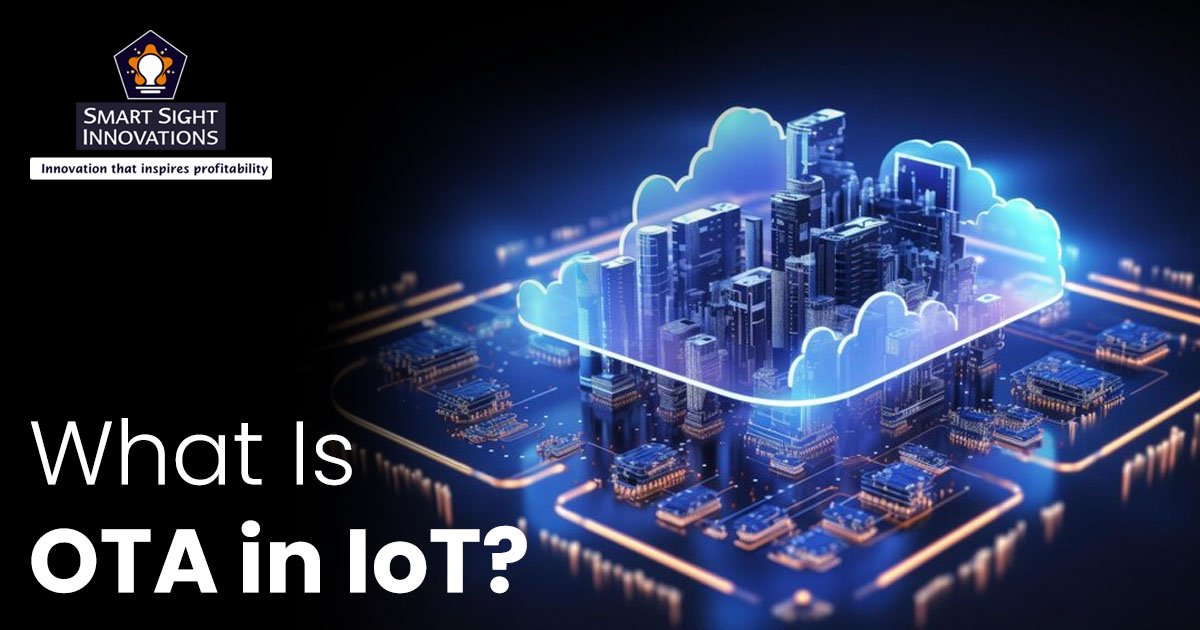
The rapidly increasing reach and functionalities of IoT devices relies on constant updates and improvements. Traditional methods often involve physical intervention, but what if updates could be delivered remotely?
This is where OTA (Over-the-Air) updates come into play. This article explains the role of OTA in IoT, exploring how it works, its advantages for both users and device managers, and the security considerations involved. It also sheds light on the different OTA update methods and how they ensure seamless updates for your connected devices.
What Is OTA in IoT?
OTA refers to the process of wirelessly distributing software updates, configurations, and encryption keys to devices. In the context of IoT, OTA updates allow manufacturers and service providers to deploy new software or firmware versions to devices remotely.
This capability is crucial for maintaining and enhancing the functionality, security, and performance of IoT devices without the need for physical intervention.
The Challenge of Device Management in IoT
IoT can enable seamless communication between interconnected devices, generating valuable data and streamlining processes. But managing a vast network of devices across diverse locations presents a significant challenge.
-
Heterogeneity
IoT deployments involve a multitude of devices from various manufacturers, with different operating systems, communication protocols, and security features. This heterogeneity makes it difficult to establish a one-size-fits-all management approach.
-
Scalability
As IoT deployments grow, managing a large number of devices becomes increasingly complex. Traditional manual methods become inefficient, requiring automated solutions for provisioning, configuration, and monitoring.
-
Security Threats
With a vast attack surface, unsecured devices introduce vulnerabilities to the entire network. Regular security updates and firmware patches are crucial, but remotely deploying them across a large number of devices requires robust security protocols.
-
Remote Access and Control
Many IoT devices are deployed in remote locations, making physical access for maintenance or troubleshooting impractical. Efficient remote access is essential for configuration changes, data collection, and troubleshooting issues.
-
Device Lifecycle Management
As IoT devices have a finite lifespan, managing the lifecycle, including provisioning, updates, decommissioning, and secure data disposal, requires a well-defined strategy for long-term success.
-
Limited Resources
Many IoT devices have limited processing power, memory, and battery life. Device management solutions need to be lightweight and efficient to avoid impacting device performance or draining battery life excessively.
These challenges highlight the need for robust device management platforms specifically designed for the demands of the IoT landscape.
Components of OTA Systems
An effective OTA system relies on integrating various components. Each element is essential for maintaining the functionality, security, and performance of IoT devices in an increasingly connected world. The primary components of OTA systems and their roles in the update process are:
1. Device Firmware/Software
The firmware or software on IoT devices is the core component that controls their operations and functionalities. It is this software that receives updates through the OTA system. Firmware is typically embedded into the device’s hardware, while software may refer to applications or operating systems running on the device. The ability to update this software remotely is what makes OTA so powerful, allowing for continuous improvement and maintenance without physical access to the device.
2. Update Server
The update server is a central component in an OTA system. It hosts the new software or firmware versions and manages the distribution of these updates to devices. The update server’s responsibilities include:
- Storing the updated firmware or software files.
- Managing the rollout of updates, and allowing for phased deployments to minimize risks.
- Limiting access to the updates to just approved devices.
- Keeping records of update activities and monitoring the status of updates to ensure successful deployments.
3. Communication Protocols
Communication protocols are the methods and standards used to facilitate communication between the update server and IoT devices. These protocols ensure that update data is transmitted efficiently and securely. Common protocols used in OTA systems include HTTP/HTTPS, MQTT (Message Queuing Telemetry Transport), and CoAP (Constrained Application Protocol).
These protocols handle the download of update packages, as well as the communication of update status and other necessary data.
4. Security Mechanisms
Robust security mechanisms are necessary to protect the update process from potential threats and ensure the integrity and authenticity of the updates. Some key security features include encryption, digital signatures, authentication, and integrity checks.
5. Device Management System (DMS)
DMS is often integrated with OTA systems to provide comprehensive oversight and control over IoT devices. The DMS handles:
- Enrolling devices into the OTA system and assigning unique identifiers.
- Managing the entire lifecycle of devices, including initial setup, monitoring, maintenance, and decommissioning.
- Defining and enforcing update policies, such as update schedules, device groupings, and rollback procedures.
6. Updated Client Software
The IoT device directly houses the updated client software. It is responsible for:
- Communicating with the update server to check for available updates and downloading them.
- Performing security checks to verify the integrity and authenticity of the update package.
- Managing the installation process, which may include rebooting the device or switching to a new firmware version.
- Sending feedback to the update server about the success or failure of the update process.
7. User Interface and Management Console
For administrators and users, an intuitive user interface or management console is crucial for overseeing the OTA update process. This interface allows for:
- Tracking the progress and status of ongoing updates.
- Setting rules and schedules for when and how updates should be deployed.
- Gaining access to detailed reports and logs on update activity and device status.
Basic Workflow of OTA Updates in IoT Devices
The OTA update process for IoT devices is a complex yet essential workflow that ensures devices remain secure, functional, and up-to-date. By following the structured process, manufacturers and service providers can efficiently manage and deploy updates, enhancing the performance and security of their IoT ecosystems. Here is a step-by-step overview of the basic workflow involved in deploying OTA updates to IoT devices:
1. Update Creation and Testing
-
Development
Software developers create a new firmware or software update, that include coding new features, fixing bugs, and addressing security vulnerabilities.
-
Testing
The update undergoes rigorous testing in a controlled environment to ensure it is stable, secure, and compatible with the target devices. This phase includes unit tests, integration tests, and system tests.
-
Validation
The update is validated against a set of predefined criteria to ensure it meets the required standards and performs well under various conditions.
2. Update Packaging
-
Packaging
Once the update passes all tests, it is packaged into a format suitable for distribution. This package includes the updated code, metadata (such as version number and release notes), and cryptographic signatures for security.
-
Encryption
The update package is encrypted to prevent tampering and unauthorized access during transmission.
3. Update Deployment Preparation
-
Distribution Strategy
A deployment strategy is planned, which includes staged rollouts..
-
Scheduling
Updates are scheduled for deployment at times that minimize disruption, such as during off-peak hours.
4. Update Distribution
-
Notification
Update notifications are sent to IoT devices. This can be done via push notifications or by having devices periodically check for updates.
-
Download
Devices download the update package from a server or edge node. The download process may include error-checking to ensure the package is complete and uncorrupted.
5. Update Verification
-
Integrity Check
After downloading, the device performs an integrity check on the update package using cryptographic signatures to ensure it has not been tampered with.
-
Compatibility Check
The device checks the update for compatibility with its hardware and current software version to prevent potential issues.
6. Update Installation
-
Backup
Some devices may create a backup of the current firmware or software before installing the update. In the event that the update fails, this allows a rollback.
-
Installation
The device installs the update. This may involve temporarily shutting down certain functions or rebooting the device.
-
Verification
After installation, the device checks to make sure the update was installed properly and that it is operating as it should.
7. Post-Update Monitoring
-
Initial Monitoring
Immediately after the update, the device undergoes initial monitoring to ensure it operates correctly. Any issues detected at this stage can trigger an automatic rollback to the previous version.
-
Feedback Collection
The device sends feedback data to the server, including installation status, performance metrics, and any error logs.
8. Rollout Completion
-
Staged Rollout Monitoring
In staged rollouts, the initial group of updated devices is monitored for a predetermined period. If no significant issues are found, the update is progressively rolled out to more devices.
-
Full Rollout
Once the staged rollout is deemed successful, the update is deployed to all remaining devices.
9. User Notification
Users are notified of the update completion and any new features or changes they need to be aware of. This can be done through app notifications, emails, or user interfaces on the device.
10. Continuous Improvement
-
Data Analysis
Data collected during and after the update process is analyzed to identify any issues and areas for improvement. This feedback loop helps improve future updates.
-
Maintenance
Regular updates and maintenance are scheduled to keep devices secure, functional, and up-to-date.
Different Types of OTA Updates
There are several types of OTA updates, each serving different purposes and addressing specific needs within the IoT ecosystem.
1. Firmware Updates
Firmware updates are the most fundamental type of OTA updates. It is a low-level software that directly interacts with the hardware of the device, controlling its basic functions. Firmware updates are typically critical and require careful handling to ensure they do not disrupt the device’s operation. OTA firmware updates are essential for:
- Resolving issues and bugs that affect device performance.
- Addressing vulnerabilities to protect against threats.
- Adding new functionalities or improving existing ones.
- Making the device run more efficiently.
2. Software Updates
Software updates involve higher-level applications or operating systems that run on the IoT device. Unlike firmware updates, software updates can often be rolled out more frequently and with less risk of bricking the device. These updates are crucial for:
- Enhancing the look and feel of the user interface for better user experience.
- Introducing new capabilities and functionalities to the device.
- Ensuring the device remains compatible with other systems and platforms.
- Improving the speed and efficiency of software applications.
3. Configuration Updates
Configuration updates involve changes to the settings and parameters that control how the device operates. Configuration updates are typically smaller in size and less disruptive than firmware or software updates. These updates are essential for:
- Updating Wi-Fi credentials, server addresses, or other network configurations.
- Adjusting thresholds, limits, or other operational parameters to optimize device performance.
- Modifying encryption keys, authentication credentials, or other security-related settings.
4. Security Updates
Security updates are specialized OTA updates focused solely on enhancing the security of the IoT device. These updates are vital for:
- Fixing security holes that could be exploited by malicious actors.
- Implementing more robust encryption methods to protect data.
- Improving methods for verifying the identity of devices and users.
Given the increasing number of cyber threats targeting IoT devices, regular security updates are crucial for maintaining device integrity and user trust.
5. Bootloader Updates
Bootloader updates are less common but critically important. The bootloader is a small program that runs before the main firmware, initializing the hardware and loading the main firmware. OTA bootloader updates are necessary for:
- Ensuring the bootloader can properly load and execute updated firmware.
- Enhancing security checks to stop unauthorized firmware from operating during the boot process.
- Resolving bugs or issues that occur during the boot process.
Because the bootloader is fundamental to the device’s operation, these updates must be handled with extreme care to avoid rendering the device inoperable.
6. Application Updates
Application updates refer to changes made to specific applications running on the IoT device. These updates are important for:
- Adding new functionalities to applications.
- Fixing bugs within the application.
- Optimizing the application for better performance.
Application updates are often more frequent and user-driven, depending on the app’s requirements and user feedback.
Importance of OTA in IoT Devices
The rapid expansion of the IoT has brought about a multitude of connected devices that require constant updates and maintenance. OTA updates provide a critical mechanism for managing these devices efficiently and effectively. Here are the key reasons why OTA updates are indispensable in the IoT landscape.
1. Ensuring Security and Compliance
Security is one of the main concerns in the IoT ecosystem. With a vast number of devices connected to networks, the potential for cyber threats and vulnerabilities increases significantly.
OTA updates are essential for deploying security patches and updates promptly to protect devices from emerging threats. Regular OTA updates ensure that devices adhere to the latest security standards and protocols, minimizing the risk of data breaches and unauthorized access.
In addition to security, OTA updates help ensure compliance with regulatory standards and industry best practices. Regulatory bodies often update guidelines to address new risks and technological advancements.
2. Enhancing Device Functionality and Performance
One of the primary benefits of OTA updates is the ability to enhance the functionality and performance of IoT devices continuously. Manufacturers can release new features, improve existing functionalities, and optimize performance through remote updates. This capability is crucial in a rapidly evolving technological landscape, allowing devices to stay relevant and competitive.
For example, a smart home device can receive updates to support new voice commands, integrate with additional smart home ecosystems, or improve energy efficiency. These enhancements not only improve the user experience but also extend the device’s lifespan, reducing the need for frequent hardware replacements.
3. Reducing Maintenance Costs and Downtime
Traditional methods of updating software or firmware on IoT devices often require physical access, which can be costly and time-consuming. As OTA updates eliminate the need for manual intervention, it significantly reduces maintenance costs.
This remote update capability is particularly beneficial for devices deployed in hard-to-reach locations or large-scale deployments, such as smart meters, industrial sensors, or agricultural equipment.
Moreover, OTA updates help minimize device downtime by enabling quick and efficient deployment of fixes and improvements. Reducing downtime is critical for businesses that rely on IoT devices for essential operations, as it ensures continuous productivity and efficiency.
4. Supporting Scalability and Manageability
Managing the vast ecosystem of IoT devices requires scalable and efficient solutions. OTA updates provide a centralized and streamlined approach to updating devices, making it possible to manage and deploy updates to thousands or even millions of devices simultaneously.
Whether it’s a fleet of connected vehicles, a network of environmental sensors, or a collection of healthcare devices, OTA updates enable seamless and efficient management, supporting the growth and scalability of IoT deployments.
5. Facilitating Rapid Innovation
The IoT landscape is marked by rapid innovation, with new technologies and applications emerging continuously. OTA updates play a vital role in facilitating this innovation by allowing manufacturers to quickly roll out new features and improvements. Agility enables businesses to outperform rivals and adapt to changing client demands.
Additionally, OTA updates provide a feedback loop for manufacturers. By monitoring the performance of deployed updates and gathering user feedback, companies can make informed decisions about future developments and enhancements. An innovative and continuous improvement culture is created by this method.
6. Improving User Experience and Customer Satisfaction
Users benefit from devices that remain up-to-date with the latest features, security measures, and performance optimizations. This ongoing improvement fosters trust and loyalty, as customers know their devices will continue to meet their needs and expectations.
For instance, a wearable health device can receive updates to improve accuracy, add new health monitoring features, or enhance user interface elements. These updates improve the overall user experience, making the device more valuable and reliable.














